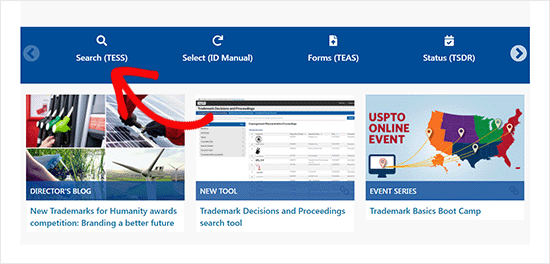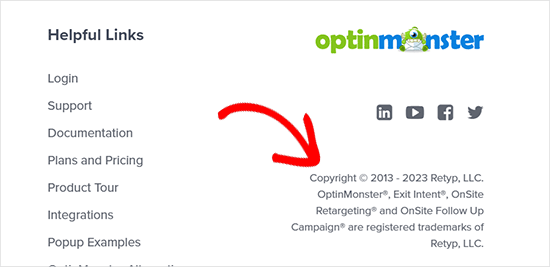Protecting your blog’s name and logo is essential for your brand. Trademarking and copyrighting help shield you from unauthorized use and legal issues.
In this guide, we’ll show you how to trademark and copyright your blog’s name and logo. Securing these protections ensures your brand stays unique and safe.
We’ll cover the basics and explain the steps in simple terms. Let’s get started on protecting your blog’s identity.

Note: Nothing in this article should be considered legal advice. For any matter of clarification, please consult an attorney.
Why Should You Trademark and Copyright Your Blog Name and Logo?
You don’t have to register a trademark to create a business website in the United States. If you have a small personal blog or a small business site without plans to expand, your creative works are already protected by copyright.
However, if you do business in multiple states and plan to grow, registering your trademark and copyright is essential.
Registering gives you exclusive rights to your business name and logo. This means you can stop others from using a name or logo that’s too similar.
It also makes you responsible for enforcing your trademark. If someone infringes on your rights, you’ll need to send a cease and desist letter and possibly take legal action.
What Is the Difference Between Trademark and Copyright?
Copyright and trademark protect intellectual property rights, so people often confuse the two terms.
What Is Copyright?
Copyright applies to creative works, including written words, text, images, illustrations, artwork, and more. As soon as a work is put in a tangible form, it is protected by the copyright laws.
In simpler terms, all original content on your WordPress website is protected by copyright laws without you doing anything extra.
What Is a Trademark?
Trademarks, on the other hand, are word marks, business names, symbols, sounds, or colors that distinguish goods and services from those manufactured or sold by others and indicate the source of the goods.
A government body responsible for registering patents and trademarks in your jurisdiction can register a trademark.
In plain words, this can be your business name, logo, brand mascot, or product name. However, you cannot register your own name as a personal brand unless it is truly unique and widely recognized, such as Marks & Spencer, Johnsons & Johnsons, or Calvin Klein.
It is important to remember that copyright doesn’t give your business or logo the same protections offered by a registered trademark. For example, some part or all of your copyrighted work can be used under the ‘Fair Use’ principle.
Registered trademarks cannot be used, allowing you to protect your brand against impostors using similar names to mislead your potential customers.
If you have already registered as a business in your state, then this doesn’t automatically protect your business name as a trademark. In fact, someone can register the same or similar name as a trademark and potentially stop you from using it.
How to Apply for a Trademark
First, you need to understand what you can submit as a trademark in your application.
- You cannot submit a name that someone else is already using as their trademark.
- Your name cannot be too similar to an existing trademark.
- It needs to be unique and not too generic.
Next, you need to thoroughly search for the existing trademarks using the Trademark Electronic Search System or TESS on the United States Patent and Trademark Office website.

This step is really important as it can save you money if someone else has already registered or applied for the same trademark.
You can search for word mark, word or design mark, or use advanced search for free form combinations.

If the trademark is not registered, then you can go ahead and apply for it by visiting Trademark Electronic Application System or TEAS, which is available on the United States Patent and Trademark Office (USPTO) website.
There are three different application forms available with different fees. You will also find information on which form to choose for your application on the page.
The application forms are quite detailed, and you need to fill in all the required fields.
Once you submit the application form, you will receive an email confirmation. After that, you need to wait for approval.
Filing a trademark application is a legal process that needs to be handled carefully. We recommend hiring a lawyer to help you apply for the trademark.
You can also use online legal service providers like CorpNet or LegalZoom, which provide legal services to small businesses and individuals at a low cost.
How to Copyright Your Blog’s Logo
As we mentioned earlier, all creative works are automatically protected by copyright laws as soon as they are put in a tangible form. However, registering your copyright will help you add an extra layer of protection on top of your copyright.
Depending on where you are located, you can usually find where and how to apply for copyright in your region online. The process will be different depending on your country’s laws and procedures.
If you are located in the United States, then you can apply for copyright by visiting the United States Copyright Office website.
You will first need to find the appropriate category for your creative work. For example, if you are applying to copyright your logo, then you will click on the visual arts section. For blog content, you will need to visit the ‘Other digital content’ category.

You can download the application form with instructions in different formats on the next page.
You can also apply for copyright registration online. You will have to provide copies of the work you are trying to protect. For example, in the case of a logo, you can provide hi-res images.
Once you have applied for the copyright, depending on the number of applications, the copyright office may take a long time to respond.
If you find the process complicated, you can use services like CorpNet or LegalZoom, which offer low-cost legal services for small businesses and individuals.
Enforcing Your Trademark and Copyright
Once you have registered your trademark or copyright, you are responsible for protecting it against infringement. Even though the USPTO office will not allow anyone to register the same or similar trademark, people can still use it without registering.
The first step in protecting your trademarks and copyright is to indicate your registered trademarks and copyright protection on your website.

The Trademark and Copyright symbols let others know they cannot use your protected properties for business.
If someone has stolen your blog content or logo, you can send them a cease and desist letter asking them to remove the content.
You can also file a DMCA (Digital Millennium Copyright Act) complaint with their hosting provider and search engines like Google to take down the stolen content.
We have also created a complete guide on preventing blog content scraping in WordPress.
If a business or blog starts using your registered or pending registration trademark, you can send them a cease and desist notice, too. You can also start legal proceedings to take further action if necessary.
We hope this article helped you learn how to trademark and copyright your blog’s name and logo. You may also want to see our guide on making money online and our expert picks for the must-have WordPress plugins to grow your website.
If you liked this article, then please subscribe to our YouTube Channel for WordPress video tutorials. You can also find us on Twitter and Facebook.





Tom Bale
Trademark registration is a vital step for businesses like Regimark to protect their brand identity and intellectual property. It not only secures exclusive rights but also builds trust and credibility among customers. By registering your trademark, you safeguard your unique name, logo, or tagline against infringement, ensuring long-term growth and legal protection. It’s a proactive move that adds significant value to your brand in today’s competitive market.
Samuel
many a time i have been asked if i do copyrighting and trademark by prospective clients and my usual answers no and as a result I have lost many job opportunity. it is a thin of joy to me when I found this article on your blog this morning. Thanks for enlighten me on the difference between copyright and trademark. I can now offer service or advice to prospective client who may require or need to know about these important legal tools to prevent one assets from being taking over by other. Thanks for much for this guide.
Dennis Muthomi
I’d like to highlight the importance of the trademark search using TESS. From personal experience, I can’t stress enough how crucial this step is.
I once had a client who skipped this step and ended up having to rebrand entirely, which was costly and time-consuming.
Samuel
Couldn’t agree more on the important of Trademark registration, At least twice this has happened to me too, only for me to start redesigning the Clients logo and other assets because of trademark issue. It is very important one should not just assume that because you can think of a name or just design a logo then it is available for use. The proper thing is to trademark it to be sure.
Dennis Muthomi
Love hearing from someone else who’s dealt with trademark headaches! It’s amazing how common these issues are in our field, isn’t it? I’ve definitely been there with having to redo client work because of trademark conflicts – such a pain that could’ve been avoided with good research. Really appreciate you sharing your experience here
sapna
Great Article.Thnks for sharing .I have been searching for such an informative post since many days and it seems my search jst ended here.Good work.Keep posting
WPBeginner Support
Glad our guide could be helpful!
Admin
devahk
Nice and helpful guide. It is really important to register your trademark to avoid future conflicts.
Erin McMullen
Thank you for the post. It is really important to register your trademark to avoid future conflicts.
WPBeginner Support
You’re welcome, thanks for sharing your opinion
Admin
Shivani
Nice and helpful guide. Thank you for this and keep posting these kinds of posts in the future.
WPBeginner Support
Thank you, glad you liked our article
Admin
Shivam
Very Nice Article and Informative. Keep Writing.
WPBeginner Support
Thank you, glad you like our article
Admin
Daniel Jameson
Every element of your brand can be trademarkable. Original works” of architecture, audio-visual, choreography, drama, graphics/pictures, literature, music and sculpture, as well as sound recordings, software, and even your business website is subject to copyright.
Somsri
Thank you so much, your blog post just shown a path to deal with my imposters.
If possible please write some articles on website takedown also, that will be very helpful for some victims like me.
I have seen lots of google blogger users do this. So it could be helpful for us to take them down.
Regards
Jane H Johann
Relevant and USEFUL! Thank YOU so much!
Chris
Its also fair to mention that initiating legal proceedings may cost you at least 5k so choose your battles and if you lose it may cost a lot more.
Soumik Sadman Anwar
Nice article but what is the process for non-US website owners?
Hossain Ahmad
Exactly what i was thinking. What will be the process of non-US website owner?
Thank you.